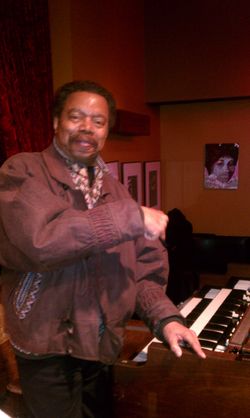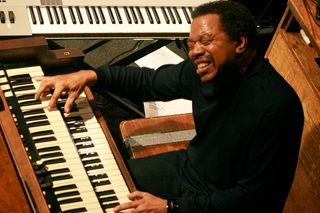The other day, in a Facebook post about an organ rental I’d just done, I included a photo of a particularly lovely Hammond B-3. The post stimulated a lot of comments--mainly about the photo! The pictured B-3 was indeed a beauty--and as it happens, there’s an amusing story about it.
Just as B.B. King named his guitar ("Lucille“), I name my B-3's. Their names, almost always beginning with the letter B, usually evoke the image of large, homely women: e.g., Bertha, Belinda, & Beulah. But this particular organ--which I bought with the intention of repairing, then reselling--was so lovely that I dubbed it "Beyonce." Until Tracy got mad, that is. (She saw that all of a sudden I was in no hurry to sell the organ!) We did need the money, so I renamed the B-3 "Brunhilda" and promptly sold it. :-(

"Beyonce" (aka "Brunhilda")
Recalling the story of that organ suggested an interesting topic for this blog: the many Hammonds I’ve owned & played over the decades. OK, that might not sound like too riveting a topic for any save hard core “organ nerds" (as Tracy famously dubbed my organ-playing friends). But stay with me…
My first Hammond Organ was a little spinet model: an M-3. Call it a starter organ. Booker T. Jones actually recorded “Green Onions” on an M-3. According to legend, he held the mic between his knees, as the sound of an M-3 emanates not from a Leslie Speaker but from a pair of speakers built into the front of the console. But like everyone else, Booker graduated to a B-3 as soon as he had the funds. (In his case, Stax Records was suitably impressed with sales of “Green Onions” to break down and buy a B-3 & Leslie.)

The Hammond Model M-3
My folks bought my M-3, which I’d spotted in the San Francisco Chronicle’s classified ads, for a few hundred bucks. But soon I was bugging them about getting a full sized Hammond, so they got me a 1940’s model CV I’d fallen in love with. That organ had been located in an organ repair shop in SF‘s Richmond District. (The repairman spent most of his time in the bar a few doors down from his shop, and he didn’t mind me playing the CV while he was getting toasted.)
I loved the CV, but soon I was after my parents again: this time, to have the big axe “chopped,” or made portable. Soon they agreed, and organ tech Bob Schleicher did the deed. Now, these days Bob makes gorgeous cut-down Hammonds, dubbed “The Oakland Chop.” But the axe he built for me--his first effort--looked more like a tank than an instrument. The good news was that the organ now fit in my dad’s International Travelall--basically an oversized station wagon. The bad news was that it was even harder to lift than the un-chopped CV had been!
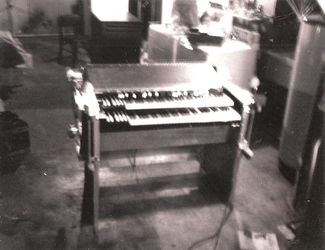
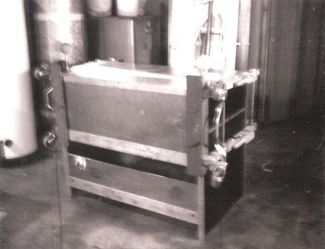
Schleicher chopped CV, front view Schleicher chopped CV, rear view
Next, I learned about Keyboard Electronics, a company in L.A. that was chopping B-3’s for top touring bands. The owner of this company, Bill Beer, was an impressive guy--a former NASA rocket scientist, no less--and he was able to persuade my parents that having him re-do the chop job on my organ was worthwhile. (They were especially impressed when he used the word “synergistic”--then a pretty arcane term.)
My new Keyboard Products chopped CV was indeed an upgrade: cool-looking and much easier to transport. When Chester Thompson attended his first Tower Of Power rehearsal, I provided my organ for the occasion and CT was blown away. (The band promptly ordered one for Chester to use, as he didn’t own an organ at the time.) But before long, I was unsatisfied yet again. I’d noticed that the tone of the organ was now less crisp; the attack was a little “fuzzy.” The cause? Keyboard Products used a solid state pre-amp in their chops. When I phoned Beer to complain about this, he listened politely but said he didn’t know what I was referring to.
So I did what any obsessed young organist would do: I put the chopped organ along with a stock B-3 in a trailer and drove it down to L.A. so that Beer could hear the two instruments side by side! His response? He said he couldn’t hear the difference, but showed me on a graphic print-out how his pre-amp was superior to the crude tube pre-amp in the stock B-3. I then realized the futility of discussing tone with a NASA scientist and drove back home. Soon afterwards, I sold the cut-down, bought a van, and commenced hauling the stock B-3 to all my organ gigs.
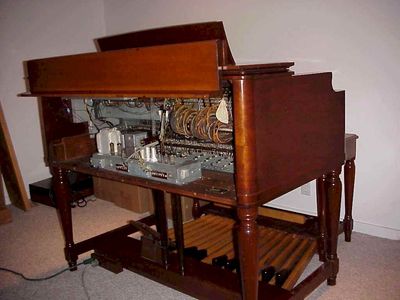
The guts of a stock B-3; the "crude" preamp is at front
End of story? Not exactly. I was pretty satisfied with my stock B-3, but was aware that it didn’t sound quite as cool as the ones on some of my records--e.g., Jimmy Smith, Jimmy McGriff, & Booker T. albums. Then one night I played the house organ at an SF club called the Off Plaza. What a difference!! It was a revelation, a life-changing experience. I had to have that organ! However, the club owner wouldn’t sell it to me or anyone else (CT, who had played weekends at the club before joining TOP, was among the organists who had tried).
So I began a search for another B-3 like the Off Plaza axe (a singer friend had dubbed it “Esmerelda.”) Over the next several years, I bought a few B-3’s that sounded great in the sellers’ living rooms. But when I got them on a gig it was always the same old disappointment: they lacked bass or volume, or they were too muddy & didn’t project--it was always something. I even had one organ extensively modified in an attempt to replicate the sound I wanted. Another dud: I re-sold that organ like all the others.
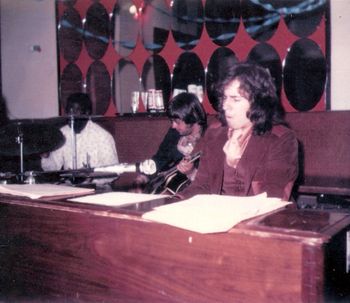
Playing a B-3 I'd bought from S.I.R. in SF. Not bad, but not "Esmerelda"
Finally, I wrote down the serial number of Esmerelda and began narrowing my search to organs of that vintage (B-3’s were made from ‘54 to ‘74; Esmerelda was from the late ‘60s). That led to my buying an organ that was closer to what I’d been looking for--a black B-3 that I own to this day (which I dubbed “Belinda”). But it still wasn’t quite “it.” Then, finally, I found a B-3 that was very close to my dream girl---er, organ. It screamed, it purred, it projected while having plenty of fullness. At last, my quest was at an end. I dubbed the B-3 “Bertha” and we lived happily ever after.

With Lucky Peterson & "Belinda" (photo: Ross Hamilton)
Well, almost. After moving to Portland, Oregon, Bertha & Belinda in tow, I made the acquaintance of a young organist who seriously coveted Bertha the Hammond. He was as smitten & obsessed as I had been with Esmerelda back in the day. I gave him Bertha’s serial number and he began buying and discarding B-3s at a dizzying rate. None satisfied him, as none compared to Bertha.

Playing "Bertha" with the Paul deLay Band
One day I mentioned to him that, long ago, I’d played an organ that even sounded slightly better than Bertha. He asked what ever happened to it? I told him that, come to think of it, I’d heard that the Off Plaza’s owner had passed away. Maybe the organ could be purchased now... I said, “Let me look into it; if I’m able to buy Esmerelda, and if I decide I really do like her better than Bertha, then you can have Bertha. That‘s if you make the trip down to SF for me to pick up Esmerelda.” He was thrilled at that proposal, and ultimately, after I’d purchased Esmerelda from the club owner’s widow (that process was a story in itself), the young organist drove down to SF, picked up the storied axe, and returned to Portland.
We then set Bertha (call her my wife) and Esmerelda (call her my youthful unrequited love) side by side in Tracy’s home and turned them on. Both sounded fantastic, but there was no question: Esmerelda had that special something. A guitar player in SF had called it, “tuff tone.” Within minutes, I’d sold my faithful Bertha like she was a sack of potatoes. And, sadly, the young organist, despite his now possessing the B-3 of his dreams, went home dissatisfied! That’s how remarkable Esmerelda the Hammond truly is.
These days, Esmerelda mainly sits on stage at Jimmy Mak’s or resides in the back room by the pool table. Once, when CT was in town with Santana, I was driving him to his hotel. Taking a slight detour, I pulled up in front of Jimmy Mak’s and told Chester that an old friend of his was inside. CT got nervous: he wondered whether I’d somehow arranged for some old girlfriend to meet him, and he’s happily married! When I took Chester inside and he saw Esmerelda, he ran his hands over her for a moment and sighed.

Chester Thompson (in San Francisco, mid-70s)
But then, every organist who plays Esmerelda feels that way. When I rented her out to Hank Crawford & Jimmy McGriff, they said I’d made their gig: that Esmerelda had been far & away the best B-3 they’d played on that tour. Al Kooper said she was the best organ he’d ever encountered on tour, period. Joey deFrancesco tried to buy her from me; he said just name my price. Dr. Lonnie Smith didn’t bother with the buying part--he just started referring to Esmerelda as his organ and said he’d be taking her with him at the end of the night! Made me a little nervous…
And you probably thought a B-3 was a B-3!
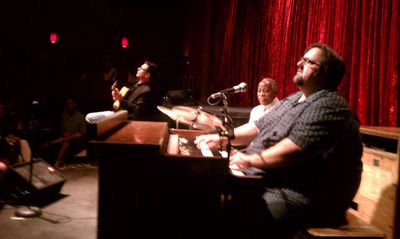
Joey deFrancesco playing "Esmerelda" @ Jimmy Mak's
- - - - - - - - - - - - - - - - - - - -
UPDATE:
On March 8 & 9, 2013, I arranged for Chester Thompson to visit Portland to play at a benefit for his former Tower of Power bandmate, Bruce Conte. (Bruce was dealing with financial issues related to his leukemia.) When telling Chester about the benefit (including a pair of gigs and a workshop, all at Jimmy Mak's), I mentioned that he'd have a chance to be reunited with Esmerelda. Chester liked that idea, and he thoroughly enjoyed the reunion (see photos below)!
